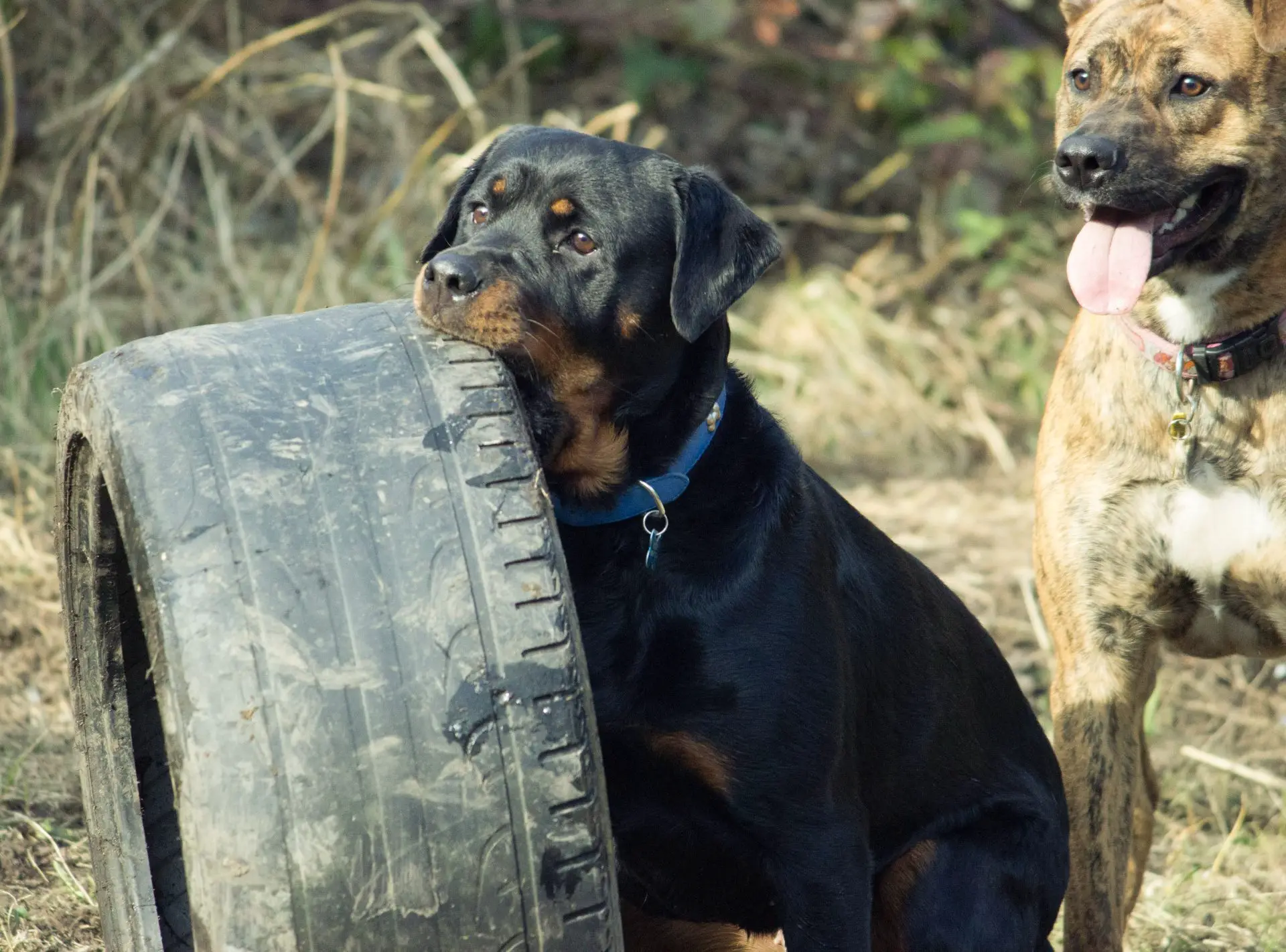rottweiler’s bite force – How Strong Is it? PSI Explained

Rottweiler’s are a large dog breed, known for their protective qualities and powerful presence. However, it is these very qualities that have fuelled an unfair reputation as an aggressive and dangerous breed.
The fact is, the Rottie is often used as a guard dog by many and even a service dog in some countries. This means that as far as dog biting stats go, the Rottweiler certainly contributes to the list. But is that just circumstantial data skewed by their occupation, or does the breed really have a serious problem when it comes to biting?
We’re happy to say that this is simply not true, the Rottweiler is a loving family dog. Yes, it has protective instincts, like many guardian breeds. The humble Rottie loves its family and is always eager to please.
TLDR;
- The average bite force of a Rottweiler is around 328 PSI, which places them in the top ten among dog breeds. This force is due to their head size, anatomy, masticatory muscles, and jaw strength.
- The measurement of bite force, typically done in PSI or Newtons, involves using a protective sleeve with a pressure gauge or a transducer placed between the dog’s teeth and a hard surface. However, these methods can yield mixed results based on the placement of the measurement tools.
- Not all Rottweilers have the same bite force as various factors like size, strength, gender, breed type, individual anatomy, and age can influence it. For instance, male Rottweilers, due to their larger head size and jaw muscles, tend to have a stronger bite force than their female counterparts.
- Rottweilers, compared to other breeds, have a stronger bite force than German Shepherds and Boxers, but lesser than breeds like the Cane Corso, Old English Mastiff, and Kangal. The breed with the strongest bite force is the Kangal.
- Despite their formidable bite force, Rottweilers are generally not aggressive, but protective. To ensure safety, potential owners should focus on early and ongoing socialisation and training. The legal implications for dog bites can be severe, hence underlining the importance of appropriate training and behaviour management.
How Strong Is The Rottweiler Bite Force?
The Rottweiler’s bite force measures approximately 328 PSI (pounds per square inch). The dog comfortably ranks among the top ten breeds in terms of bite force, demonstrating an impressive jaw strength which is well above the average canine. Yet, it’s worth noting that some other dog breeds register even higher bite force measurements.
The formidable Rottweiler bite force is largely attributable to the breed’s unique physical characteristics. Key among these are the substantial size and particular anatomy of a Rottweiler’s head, in conjunction with the robust masticatory muscles powering their jaws.
However, when analysing a Rottweiler’s bite force, one must also consider other important physical traits, such as the breed’s general pulling strength and the size of their teeth. These factors collectively contribute to the impressive Rottweiler bite force.
How is bite force measured?
Typically bite force is measured in PSI (pounds per square inch) or Newtons. However, both of these measurements can sometimes produce different results.
PSI (Pounds Per Square Inch)
PSI is measured by how much biting pressure force is applied to a certain testing surface. The pound-force per square inch is a unit of pressure or of stress based on avoirdupois units. It is the pressure resulting from a force of one pound-force applied to an area of one square inch.
Newtons
Perhaps less likely to be referenced is the biting force measured in Newtons. 1 Newton = 0.22 pounds of bite force, therefore the Rottweiler’s bite force of 328 PSI should equal around 1,490 Newtons.
How do they test bite Force?
When it comes to testing the bite force of a dog, it has become standard practice for testers to wear a protective sleeve with a pressure gauge. The dog then bites down and the result is measured. Sometimes this can deliver mixed results, depending on where the gauge is placed.
Additionally, some scientists will use a device called a transducer to measure the bite force. This is placed between the dog’s teeth and a hard surface metal plate. Once the dog bites down, the transducer will measure the pressure. This method also has its flaws, depending on where the transducer is placed.
Do all Rottweilers have the same bite force?
The 328 PSI bite force score is an average applied to the Rottweiler breed. This means that the power behind a Rottie’s bite can change per dog. There are many different factors that may lead to a stronger or weaker than average bite.
Size and Strength
The size and strength of the dog matter a lot. Rottweilers can have a lot of variance in both size and strength. According to the AKC, Rottweilers can range from 80 – 135 lbs. That’s a big difference.
The strength of the Rottweiler also doesn’t just depend on its size. It may have a high power to weight ratio, or increased muscle density.
Gender
Male Rottweilers will tend to have a stronger bite force than their female counterparts because of the increased size of their heads and jaw muscles. Alongside this is the increased weight and strength that comes with being heavier.
Rottweiler breed type
Did you know that there is more than one type of Rottweiler? There’s actually three main types of Rottie and a couple of variations such as tailed and mixed breeds. The three main types are the American Rottweiler, German Rottweiler and Roman Rottweiler. The Serbian Rottweiler is also another variation.

Each variation is raised in a different country, leading to different breeding standards but also different purposes. Some being more worker dog focused, others being more guardian focused. Over the years this may have created variations in head size, wider jaws, etc. All these aspects influence the bite force of a Rottie.
Genetics & Individual Anatomy
This includes jaw muscles, joints, teeth and more. The main muscles that control a dog’s biting force are the jaw adductor muscles. This set of muscles includes, temporal, masseter, medial and pterygoid muscles. These muscles are critical for eating and chewing. The main joint used is the temporomandibular joint (TMJ).
Put simply, the inherited genetics of their hereditary line will likely influence the size and power of these muscles and joints. Huge differences can occur from dog to dog, some may also injure these muscles or suffer from a disease like Masticatory Muscle Myositis which will weaken them over time.
Age
A sad fact of life is that we all age, it doesn’t get easier watching your dog move into its senior years. But the fact is, as your Rottie moves into old age, its muscles will become weaker. On the flip side, a young adolescent Rottweiler will keep developing its muscles and jaw strength up to the age of three.
What is the bite force of the Rottweiler compared to other dogs?
The Rottweiler makes it into the top 10 for dog biting pressure, it is comparable with other Mastiff type breeds, with the exception of the Cane Corso. The table below illustrates how the Rottie compares to other dogs.
| Dog Breed | Bite Force (PSI) |
|---|---|
| Rottweiler | 328 PSI |
| German Shepherd | 291 PSI |
| Cane Corso | 700 PSI |
| Old English Mastiff | 556 PSI |
| Pitbull | 330 PSI |
| Kangal | 734 PSI |
| Doberman | 305 PSI |
| Bullmastiff | 556 PSI |
| Boxer Dog | 230 PSI |
Comparing Rottweiler To German Shepherd Bite Force
The Rottweiler has a higher on average bite force when compared to the German Shepherd, which has a bite force of 291 PSI. The German Shepherd is commonly used as a protector and service dog too, just like the Rottweiler is in some countries.
Comparing Rottweiler to Cane Corso Bite Force
The Rottweiler has far less biting power when compared to the Cane Corso. The Cane Corso bite force is 700 PSI, which is huge. A member of the Mastiff family, the Corso is also used as a guardian breed.
Comparing Rottweiler to Old English Mastiff Bite Force
The old docile English Mastiff has a considerable bite of 556 PSI, which is higher than the Rottweiler by some distance. However, bites from this breed are very rare when compared to others on the list.
Comparing Rottweiler to Pitbull Bite Force
The Pitbull and variations of the breed are unfortunately responsible for many dog bites globally. They have a bite force of 330 PSI which is slightly lower than that of the Rottweiler.
Comparing Rottweiler to Kangal Bite Force
The Kangal leads the bite force records with a score of 734 PSI, which is substantially higher than that of a Rottweiler, and more than a Lion.
Comparing Rottweiler to Doberman Bite Force
The Rottweiler has a marginally stronger bite force than a Doberman. Both breeds suffer from a reputational issue where they are used as enforcer & protector dogs, however both also make wonderful pets.
Comparing Rottweiler to Bullmastiff Bite Force
The Bullmastiff scores a 556 PSI, identical to the English Mastiff likely due to their similarities. Therefore the Bullmastiff bite is more ferocious than the Rottweiler.
Comparing Rottweiler to Boxer Dog Bite force
Lastly, the Rottweiler has a larger bite force compared to the Boxer Dog which scores a 230 PSI. Boxer Dogs were bred to hunt and take down large prey, so their bite force and jaw structure is not to be taken lightly.
So what dog has the biggest bite force? The answer to that, is the Kangal. Followed by the Cane Corso in close second.
What is the bite force of the Rottweiler compared to other animals?
Why not for a bit of fun, let’s compare how the Rottweiler stacks up vs other animals:
| Animal | Bite Force (PSI) |
|---|---|
| Rottweiler | 328 PSI |
| Hyena | 1,100 PSI |
| Polar Bear | 1,200 PSI |
| Lion | 650 PSI |
| Hippo | 1,800 PSI |
| Saltwater Crocodile | 3,700 PSI |
| Bull Shark | 1,350 PSI |
| Gorilla | 1,300 PSI |
| Wolves | 1,000 PSI |
Summary
Based on the average scoring, the Rottweiler bite force is said to be around the 328 PSI mark. When you pair this with their size and strength, it’s quite formidable. However, the temperament of the Rottweiler is not necessarily aggressive, but protective.
Due to their role as a guardian or service dog the breed has picked up a reputation as a dangerous dog. In this sense, they have become a victim of their occupation. Many owners adore their pet Rotties as their loyal, loving companion around the house.
If you’re looking to bring a Rottweiler into the home, first off – congratulations! However, you’ll want to take safety measures around the house and ensure all your family are on the same page.
Socialisation and training are key to ongoing good behaviour and dog bite prevention. The legal implications for biting may be severe so we cannot emphasise the need for great socialisation and training from a very early age. This goes for any dog.